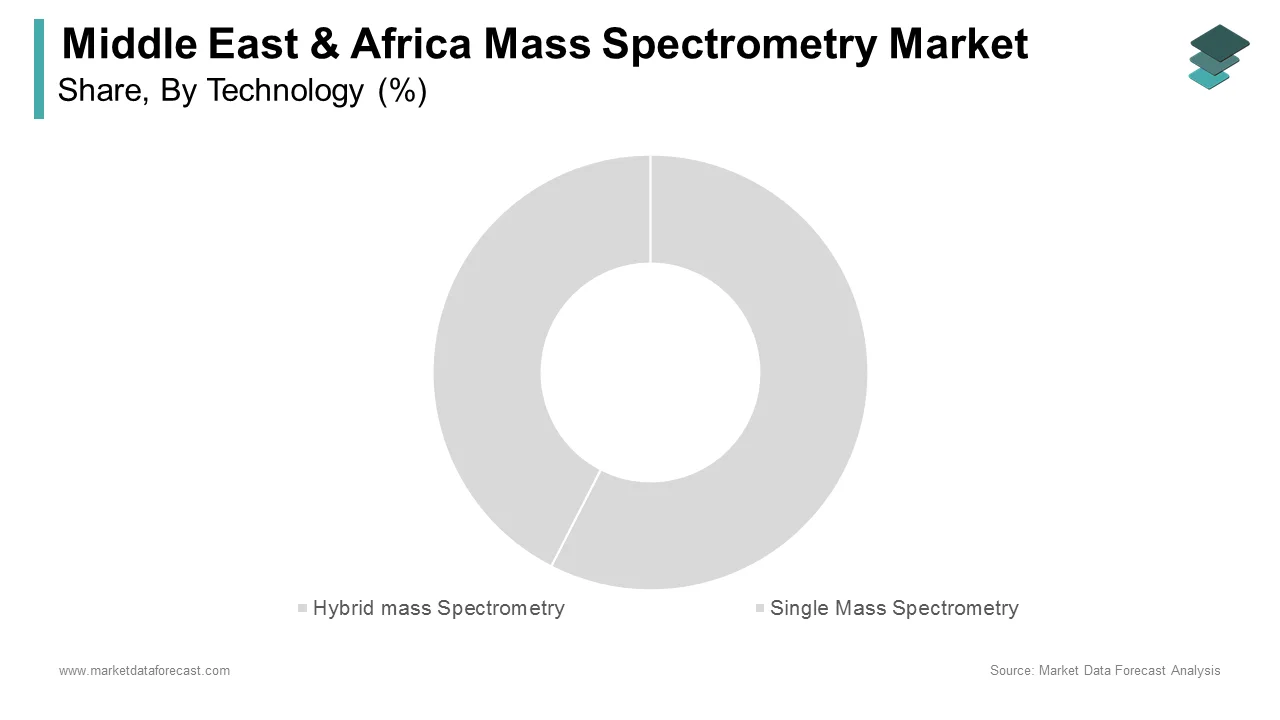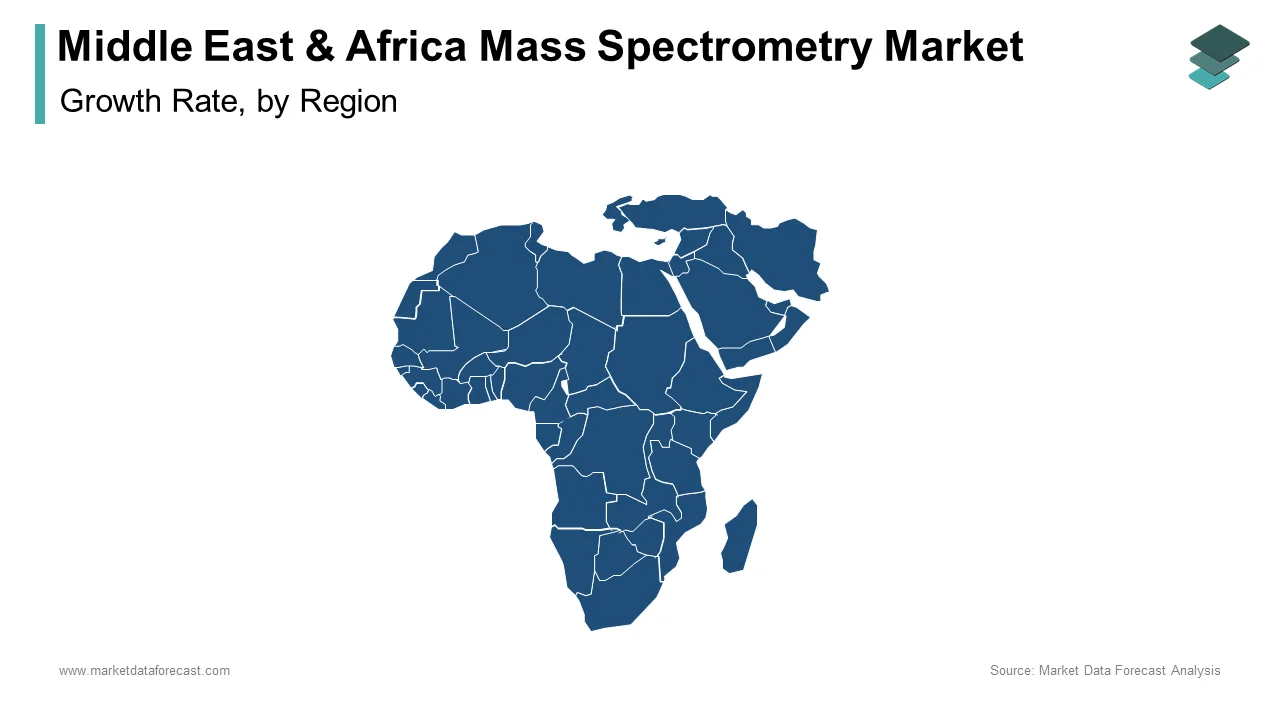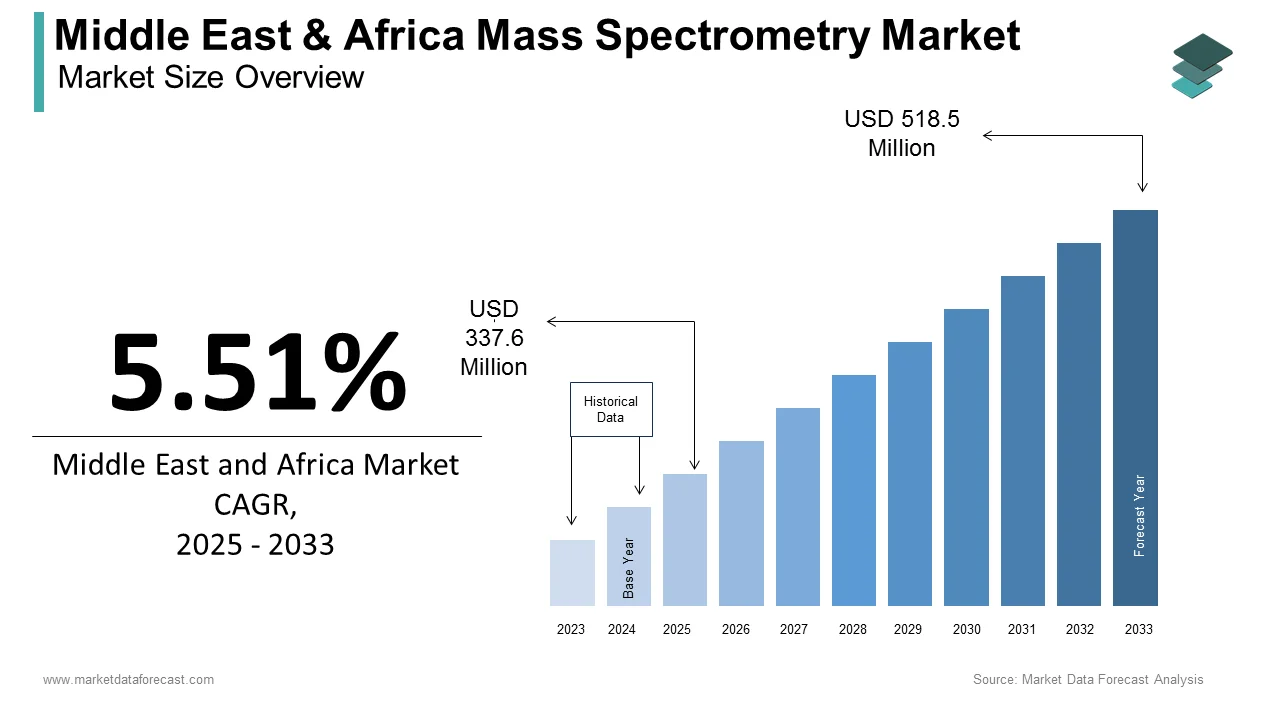Middle East & Africa Mass Spectrometry Market Size, Share, Trends & Growth Forecast Report By Technology, Application and Country (KSA, UAE, Israel, rest of GCC countries, South Africa, Ethiopia, Kenya, Egypt, Sudan and Rest of Middle East and Africa), Industry Analysis From 2025 to 2033
Middle East & Africa Mass Spectrometry Market Size
The mass spectrometry market size in the Middle East and Africa was valued at USD 320 million in 2024. The regional market is estimated to grow at a CAGR of 5.51% from 2025 to 2033 and be worth USD 518.5 million by 2033 from USD 337.6 million in 2025.
MARKET DRIVERS
The increasing interest in drug discovery and development drives the mass spectrometry market growth in the Middle East and Africa. Moreover, the increased use of hyphen technology is expected to drive the growth of the mass spectrometry market. Mass spectrometers are used to conduct versatile and efficient experiments in the discovery of ligands of high affinity for biologically related macromolecules. Hence, the increasing emphasis on drug discovery and development is expected to drive market growth during the forecast period.
Factors such as high blood pressure, high cholesterol, and obesity, lack of physical activity, poor diet, and smoking can lead to major chronic diseases such as cardiovascular disease, cancer, chronic obstructive pulmonary disease, and type 2 diabetes, which is estimated to drive the MEA mass spectrometry market. The increasing prevalence of several chronic diseases worldwide encourages pharmaceutical and biotechnology companies and research institutes to focus on drug discovery and development. This has increased R&D expenditure in the pharmaceutical industries for newer drug discovery and development among end-users. Therefore, the adoption of mass spectrometers is increasing as a robust and valuable tool for the design of structure-based drugs.
MARKET RESTRAINTS
The most recent technological developments have increased the prices of the system. The price of a spectrometer influences the purchasing decisions of end-users. Pharmaceutical companies need many of these systems, and as a result, the cost of capital increases dramatically. In addition, academic research laboratories have difficulty financing these systems because they have controlled budgets. These are the main factors limiting the adoption of mass spectrometry systems among end-users. Besides the cost of the system, the cost of complying with industry standards is also very high. Lack of knowledge about the correct choice of technology also affects the results and can generate direct and indirect costs for end-users. Currently, there is a shortage of qualified personnel for method development, validation, operation, and troubleshooting activities, which is expected to slow the growth of the mass spectrometry market to some extent in the coming years.
SEGMENT ANALYSIS
By Technology Insights

REGIONAL ANALYSIS

Over the forecast period, the market Middle East and Africa is projected to witness steady growth and improve its occupancy in the worldwide market. Saudi Arabia and UAE are likely to play the leading role in the regional market during the forecast period. The mass spectrometry market in Saudi Arabia is primarily driven by factors such as increasing funding for research and government initiatives in the region, widespread use of mass spectrometry in the metabolomics industry, and petrol. In addition, regulatory bodies in the Kingdom of Saudi Arabia (KSA), such as the Food and Drug Administration (FDA), encourage the use of analytical techniques to ensure that pharmaceutical products placed on the market meet quality requirements. Lately, the KSA has seen a significant increase in the production of shale gas and crude oil, along with an increase in oil fields, which has resulted in a subsequent increase in the use of analytical tools such as mass spectrometers. The regions of Africa have slowed and experienced weak growth due to underdeveloped populations and a lack of development in R&D.
KEY MARKET PLAYERS
Companies such as Thermo Fisher Scientific, Sciex, Agilent Technologies, Waters Corporation, Shimadzu Corporation, Bruker, PerkinElmer, Jeol, Flir Systems, MKS Instruments, Analytik Jena, Hiden Analytical, Dani Instruments, Rigaku, Leco, Kore Technology, Extrel CMS, Masstech, Ametek Process Instruments, and Advion are playing a leading role in the MEA mass spectrometry market.
MARKET SEGMENTATION
This market research report on the Middle East & Africa mass spectrometry market is segmented and sub-segmented into the following categories.
By Technology
- Hybrid mass Spectrometry
- Triple Quadrupole (Tandem)
- Quadrupole TOF (Q-TOF)
- FTMS (Fourier Transform Mass Spectrometry)
- Single Mass Spectrometry
- Ion Trap
- Quadrupole
- Time-Of-Flight (TOF)
- Other Mass Spectrometry
By Application
- Pharmaceutical Applications
- Biotech Applications
- Petrochemical Applications
- Environmental Testing
- Food & Beverage Testing
- Other Applications
By Country
- KSA
- UAE
- Israel
- rest of GCC countries
- South Africa
- Ethiopia
- Kenya
- Egypt
- Sudan
- Rest of MEA
Related Reports
Access the study in MULTIPLE FORMATS
Purchase options starting from $ 1600
Didn’t find what you’re looking for?
TALK TO OUR ANALYST TEAM
Need something within your budget?
NO WORRIES! WE GOT YOU COVERED!
Call us on: +1 888 702 9696 (U.S Toll Free)
Write to us: [email protected]

